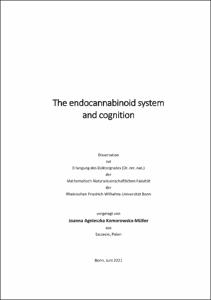The endocannabinoid system and cognition


| dc.contributor.advisor | Zimmer, Andreas | |
| dc.contributor.author | Komorowska-Müller, Joanna Agnieszka | |
| dc.date.accessioned | 2022-01-24T14:20:55Z | |
| dc.date.available | 2022-01-24T14:20:55Z | |
| dc.date.issued | 24.01.2022 | |
| dc.identifier.uri | https://hdl.handle.net/20.500.11811/9566 | |
| dc.description.abstract | THC-treatment differentially alters spines dynamics in old and young mice The endocannabinoid system (ECS) is a neuromodulatory system involved in cognitive processes. Increasing the ECS tone with low-dosage THC - a potent agonist of two main cannabinoid receptors (CB1R and CB2R) – has been shown to restore the diminished cognitive abilities of old mice back to the levels of young mice. In contrast, the same treatment in young mice had an opposite or no effect. In old mice, changes in cognition were accompanied by altered gene expression profile. Among others, upregulation of genes encoding synaptic proteins. Thus, pending the question how does THC treatment influences synapses and their dynamics. We examined the effects of chronic low-dose THC treatment on synapses by following up on the same dendritic spines before, during, and after the THC treatment using in vivo chronic imaging in 3-month and 18-month old mice. Subsequently, in 18-month old animals we investigated THC-evoked changes in microglia activity as a possible mechanism behind observed changes in the spine dynamics. We found that the timing and direction of the THC effect was age-dependent. In 18-month old mice, THC treatment increased spine density and spine stability, while decreasing spine dynamics. Investigation of microglia activity revealed that THC treatment decreased microglia phagocytic activity and contacts between microglia and neurons. In contrast, in 3-month old mice THC treatment only temporarily increased spine dynamics and thus decreased spine stability. Taken together, our investigations indicate that THC treatment differentially alters spine dynamics in young and old mice possibly through the modulation of microglial activity.
Cannabinoid receptor 2 and cognition | en |
| dc.language.iso | eng | |
| dc.rights | Namensnennung-Nicht kommerziell 4.0 International | |
| dc.rights.uri | http://creativecommons.org/licenses/by-nc/4.0/ | |
| dc.subject | endocannabinoid system | |
| dc.subject | THC | |
| dc.subject | aging | |
| dc.subject | dendritic spines | |
| dc.subject | spine dynamics | |
| dc.subject | in-vivo imaging | |
| dc.subject | neuroscience | |
| dc.subject | cannabinoid receptor 2 | |
| dc.subject | memory | |
| dc.subject.ddc | 570 Biowissenschaften, Biologie | |
| dc.title | The endocannabinoid system and cognition | |
| dc.type | Dissertation oder Habilitation | |
| dc.publisher.name | Universitäts- und Landesbibliothek Bonn | |
| dc.publisher.location | Bonn | |
| dc.rights.accessRights | openAccess | |
| dc.identifier.urn | https://nbn-resolving.org/urn:nbn:de:hbz:5-65014 | |
| dc.relation.doi | https://doi.org/10.3390/molecules26195984 | |
| dc.relation.doi | https://doi.org/10.1038/s41598-021-96285-9 | |
| dc.relation.doi | https://doi.org/10.3390/ijms22010019 | |
| ulbbn.pubtype | Erstveröffentlichung | |
| ulbbn.birthname | Komorowska | |
| ulbbnediss.affiliation.name | Rheinische Friedrich-Wilhelms-Universität Bonn | |
| ulbbnediss.affiliation.location | Bonn | |
| ulbbnediss.thesis.level | Dissertation | |
| ulbbnediss.dissID | 6501 | |
| ulbbnediss.date.accepted | 17.12.2021 | |
| ulbbnediss.institute | Medizinische Fakultät / Institute : Institut für Molekulare Psychiatrie (IMP) | |
| ulbbnediss.fakultaet | Mathematisch-Naturwissenschaftliche Fakultät | |
| dc.contributor.coReferee | von der Emde, Gerhard | |
| ulbbnediss.contributor.orcid | https://orcid.org/0000-0002-9063-2495 | |
| ulbbnediss.contributor.gnd | 1252666500 |
Dateien zu dieser Ressource
Das Dokument erscheint in:
-
E-Dissertationen (4442)




